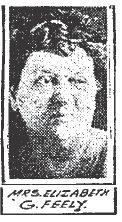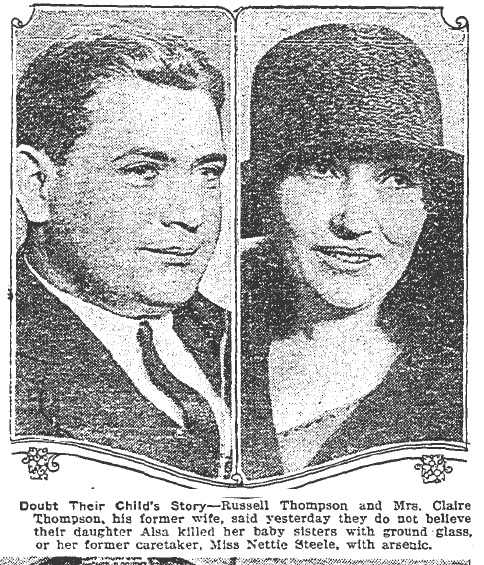 On February 3, 1925 a bizarre story broke in the local news — it was alleged that seven year old Alsa Thompson had attempted to murder a family of four with a mixture of sulphuric acid and ant paste she had added to the evening meal. The intended victims tasted the food, but it was so awful they pushed their plates away.
On February 3, 1925 a bizarre story broke in the local news — it was alleged that seven year old Alsa Thompson had attempted to murder a family of four with a mixture of sulphuric acid and ant paste she had added to the evening meal. The intended victims tasted the food, but it was so awful they pushed their plates away.
Could a seven year old actually conceive of such a fiendish plan? Evidently the Platts family, with whom Alsa had been living following her parents’ separation, thought so. It was also revealed that Alsa had taken the blade from a safety razor and slashed the wrists of her 5-year old sister, Maxine, with with whom she’d been playing.
 Alsa was taken by Policewoman Elizabeth Feeley to the Receiving Hospital where she was questioned by police and surgeons about the poisoning plot. The little girl cheerfully confessed that she had indeed attempted a quadruple homicide and that she’d done it because: “…I am so mean.”
Alsa was taken by Policewoman Elizabeth Feeley to the Receiving Hospital where she was questioned by police and surgeons about the poisoning plot. The little girl cheerfully confessed that she had indeed attempted a quadruple homicide and that she’d done it because: “…I am so mean.”
Inez Platts told the police that Alsa had come to live with the family in their home at 1540 1/2 McCadden Place, Hollywood, only two months before the poisoning incident. Alsa’s mother, Claire, worked in a downtown department store and her father, Russell, worked in Santa Ana. Apparently neither could manage custody of Alsa at the time. Inez said that ever since Alsa had arrived family members had fallen seriously ill and were under the care of their family physician. Mr. Platts had lost his voice and a couple of the children had suffered from mysterious pains.
Investigators spoke with anyone who had come in contact with Alsa and discovered that she was extremely gifted — she was already in the eighth grade. Her teachers described her as one of the best students they’d ever had, and added that she had never caused them any trouble in the classroom.
Alienists were baffled by Alsa, the doctors said that they had never before encountered a case of homicidal mania in a person so young, particularly when there was no apparent grudge against the victims.
Russell Thompson was vocal in defense of his daughter: “Alsa never poisoned any one.” When Russell was informed that Alsa had further confessed that as a 4 year old she had put ground glass into the food of her twin sisters and killed them, he said that the statement was absurd.
“The twins died when they were 2 years and 2 months of age. That was in Canada. We had two doctors and a nurse in constant attendance on them when they were ill, and they said death was due to intestinal troubles. Alsa couldn’t possibly have had anything to do with that.” No one could fault Russell for believing in Alsa’s innocence, but had he been deceived?
In his 1954 novel THE BAD SEED, William March tells the deeply disturbing tale of 8-year-old Rhoda Penmark whose mother, Christine, begins to suspect her daughter is behind a series of “accidental” deaths. When Christine’s worst fears are confirmed she has to make the difficult decision–what to do about Rhoda. If you’ve never read the book or seen the 1956 film adaptation you should. Each has a different, but shocking, ending.
Was Russell wrong? Had his beautiful daughter committed murder?
NEXT TIME: Find out if Alsa’s father was right about her, or if she was actually a high functioning sociopath capable of multiple murder, in the the conclusion of Baby Borgia.
NOTE: Many thanks to Alex Cortes. It was a conversation with him about this twisted case that lead to this post.
